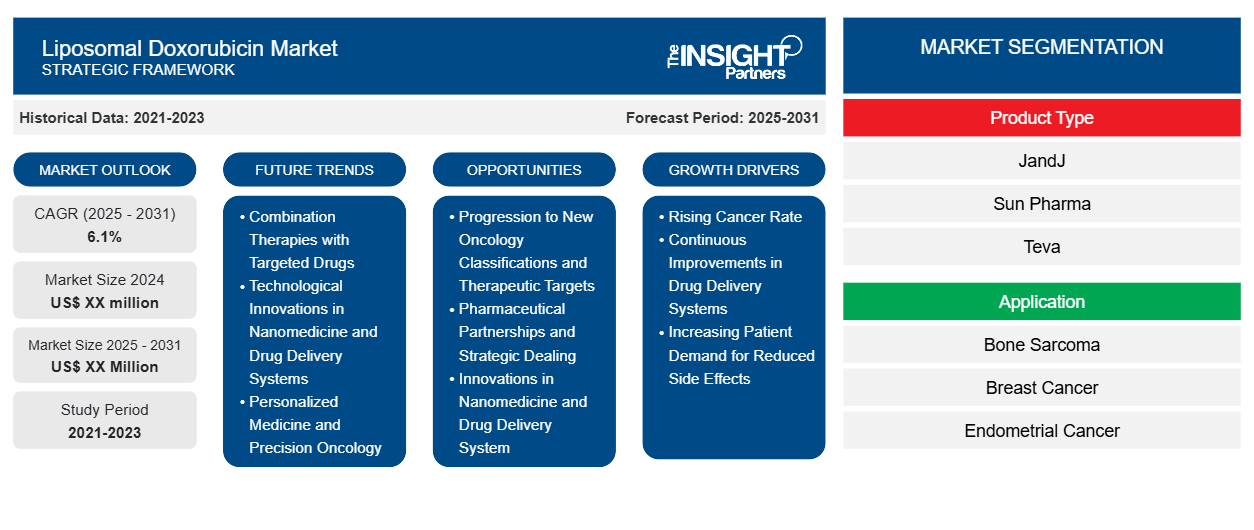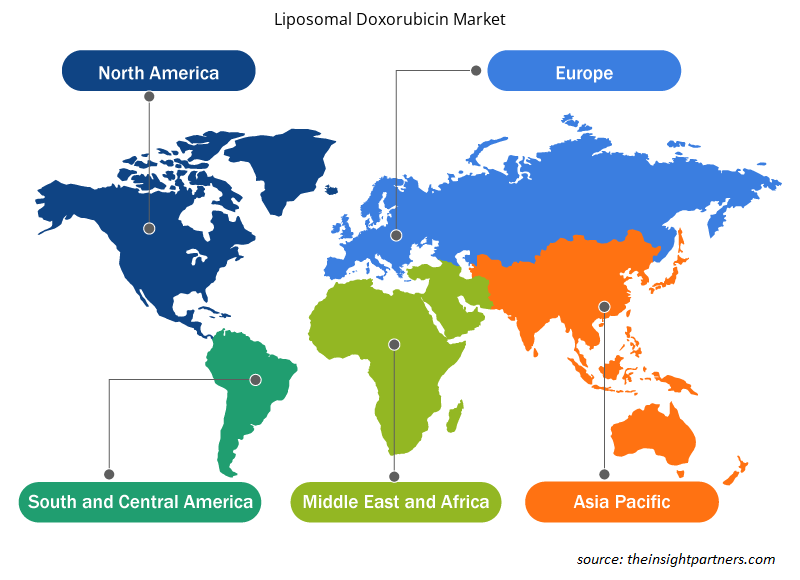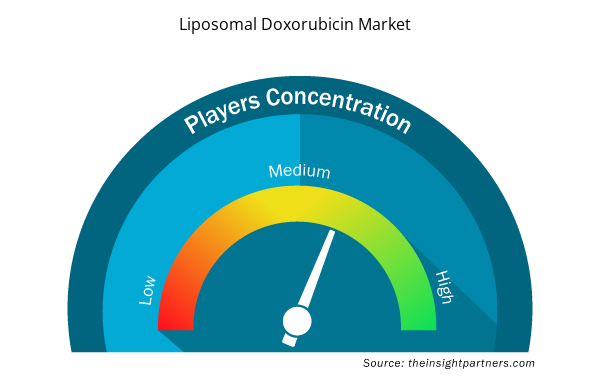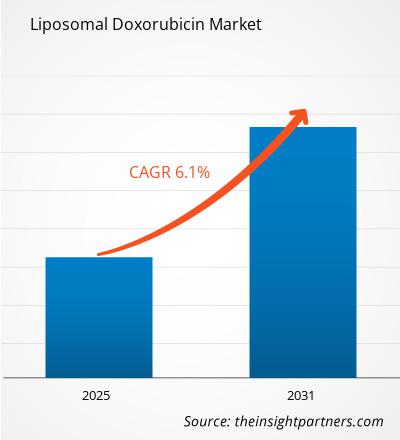The Liposomal Doxorubicin Market is expected to register a CAGR of 6.1% from 2025 to 2031, with a market size expanding from US$ XX million in 2024 to US$ XX Million by 2031.
The report is segmented by Product Type (JandJ (Doxil/Caelyx), Sun Pharma (Lipodox), Teva (Myocet), Others), and Application (Bone Sarcoma, Breast Cancer, Endometrial Cancer, Gastric Cancer, Kaposi Sarcoma, Kidney Cancer, Leukemia, Liver Cancer, Multiple Myeloma, Other Applications, Ovarian Cancer). The global analysis is broken down at the regional level and for major countries. The market evaluation is presented in US$ for the above segmental analysis.
Purpose of the Report
The report Liposomal Doxorubicin Market by The Insight Partners aims to describe the present landscape and future growth, top driving factors, challenges, and opportunities. This will provide insights to various business stakeholders, such as:
- Technology Providers/Manufacturers: To understand the evolving market dynamics and know the potential growth opportunities, enabling them to make informed strategic decisions.
- Investors: To conduct a comprehensive trend analysis regarding the market growth rate, market financial projections, and opportunities that exist across the value chain.
- Regulatory bodies: To regulate policies and police activities in the market with the aim of minimizing abuse, preserving investor trust and confidence, and upholding the integrity and stability of the market.
Liposomal Doxorubicin Market Segmentation
Product Type
- JandJ
- Sun Pharma
- Teva
Application
- Bone Sarcoma
- Breast Cancer
- Endometrial Cancer
- Gastric Cancer
- Kaposi Sarcoma
- Kidney Cancer
- Leukemia
- Liver Cancer
- Multiple Myeloma
- Other Applications
- Ovarian Cancer
Customize This Report To Suit Your Requirement
You will get customization on any report - free of charge - including parts of this report, or country-level analysis, Excel Data pack, as well as avail great offers and discounts for start-ups & universities
Liposomal Doxorubicin Market: Strategic Insights

- Get Top Key Market Trends of this report.This FREE sample will include data analysis, ranging from market trends to estimates and forecasts.
Liposomal Doxorubicin Market Growth Drivers
- Rising Cancer Rate: Growing cancer rates especially of breast cancer, ovarian cancer, and Kaposi’s sarcoma are some reasons behind the rise in the liposomal doxorubicin market. As the cancer rates around the world continue to rise as a result of population aging, lifestyle changes ,and the environment, the need for highly effective, targeted cancer treatments is rising. Liposomal doxorubicin, a chemotherapy agent packed into lipid nanocarriers, is more effective in reaching the tumor cells but less toxic to normal tissue. The drug is more effective with fewer side effects than traditional doxorubicin because of this targeted delivery mechanism. The rising global cancer rate especially among the elderly drives the demand for safer and more effective chemotherapy treatments, and the liposomal doxorubicin market is growing at a very rapid pace. The World Health Organization (WHO) and the American Cancer Society (ACS) both said that the explosion of cancer diagnoses in the world is one of the main reasons why liposomal formulations are increasingly used. For patients who desire side-effect-free and more efficacious therapies, liposomal doxorubicin is becoming the go-to choice, especially for advanced cancers. In addition, liposomal doxorubicin is increasingly combined with other therapies like immunotherapy and targeted therapy to increase clinical results which further drives the market. The rising cancer burden in developed and developing worlds is one of the primary drivers of liposomal doxorubicin’s rise and its market share in the overall oncology market.
- Continuous Improvements in Drug Delivery Systems: One of the main growth factors in the liposomal doxorubicin market is continuous innovation in drug delivery systems, especially liposomal drug delivery systems. Liposomal grafts are increasingly used for the bioavailability and targeted delivery of chemotherapeutics such as doxorubicin. Old-school doxorubicin has limitations including cardiotoxicity and systemic toxicity. Yet if you seal doxorubicin in liposomes, you can target the drug directly at the cancer cells, with fewer side effects and greater therapeutic success. Incentives for nanotechnologies and nanomedicine are increasing as well, which will further push the boundaries of more advanced liposomal solutions. Scientists are focusing on making liposomal doxorubicin more stable, bio-distributive and targetable so that the resultant treatment is more effective and less hazy. These developments are boosting the size and prospects for the liposomal doxorubicin market, as the composition becomes even more essential in individualized cancer therapy. Furthermore, liposomal drug delivery can be tailored to the molecular profile of a particular type of cancer, so tailor-made therapies can be more efficacious and individualized. Combining liposomal doxorubicin with other newer medications, including immune checkpoint inhibitors, opens up new avenues for combination therapy, which means liposomal doxorubicin will be added to the multi-drug pool. With the development of nanomedicine, such drug delivery technologies are going to offer lucrative opportunities for liposomal doxorubicin in the cancer therapy space globally.
- Increasing Patient Demand for Reduced Side Effects: Patients are increasingly asking for lower side effects, and demand for liposomal chemotherapy agents, such as liposomal doxorubicin, is increasing. Old-school chemotherapy drugs, like doxorubicin, carry major side effects: nausea, vomiting, hair loss, and, most notoriously, cardiotoxicity. These side effects not only affect patients’ quality of life but also restrict the amount of medication that can be increased for effective treatment of cancer. Liposomal versions of doxorubicin, on the other hand, decrease these levels by encapsulating the drug in lipid-derived carriers that act at the tumor and don’t pass through the body. The result is lower side effects and greater compliance and life quality in patients. More patients need minimally invasive, better-controlled cancer therapies, and liposomal doxorubicin is being pushed to replace chemotherapy altogether. As the cost of chemotherapy for patients is increasingly under threat in the long term, more cancer patients now choose liposomal medications that minimize collateral damage to normal tissue and still exert powerful anti-cancer effects. It’s a patient-first focus driving the growth as people seek therapies that balance both efficacy and safety. The liposomal doxorubicin market will see increasing patient demand as the quality of life is another area of focus in cancer treatment which will drive the market’s growth.
Liposomal Doxorubicin Market Future Trends
- Combination Therapies with Targeted Drugs: Among the major liposomal doxorubicin future trends is the combination therapies with targeted drugs and immunotherapies. Because liposomal doxorubicin can be targeted more precisely to tumor cells, it is increasingly combined with other cancer treatments, such as targeted therapies that target cancer cells’ molecular signatures. Targeted therapies – for example, HER2 inhibitors in breast cancer or EGFR inhibitors in certain solid tumors – have proven to be remarkably effective in optimizing chemotherapy as a whole. Combining liposomal doxorubicin with such targeted therapies gives doctors more control over cancer treatment, increasing cure rates and potentially decreasing drug resistance. We’re also looking at immunotherapies that can help activate the immune system to attack and destroy cancer cells, as part of liposomal doxorubicin. These combination treatments can bypass chemotherapy resistance, a common problem for advanced cancers. Clinical trials are looking into the combination of liposomal doxorubicin and checkpoint inhibitors like PD-1/PD-L1 inhibitors to generate more tailored, effective cancer treatment regimens. Combination therapies such as these will certainly help expand the market for liposomal doxorubicin, as the treatment landscape changes with every new drug approval. Liposomal doxorubicin’s association with novel therapies will be an enabler of market expansion, as oncologists are searching for novel multidisciplinary treatments for cancer.
- Technological Innovations in Nanomedicine and Drug Delivery Systems: Another accelerating trend in the liposomal doxorubicin market is technological innovation in nanomedicine and drug delivery systems. Nanotechnology could reshape cancer therapy by allowing for more accurate and efficient delivery of drugs. Liposomal drug preparations, especially, are being enhanced by nano-engineering for better, selective, and efficient drug delivery. Such advancements will optimize liposomal doxorubicin’s pharmacokinetics so that the drug reaches the tumor better and with fewer local tissues at risk for toxicity. New technology, like nanoparticles, liposomes, and micelles, are expanding the delivery of liposomal doxorubicin, which penetrates more tumors and prevents the side effects often seen with chemotherapy. This latest breakthrough in drug delivery is going to continue to fuel the liposomal doxorubicin market as it will allow it to treat an ever-larger range of cancers more effectively and safely.
- Personalized Medicine and Precision Oncology: Another big industry-changing phenomenon to impacts the liposomal doxorubicin industry is shifting into personalized medicine and precision oncology. In this type of personalized medicine, a patient's treatment becomes tailored to their genes. This is becoming the new normal for cancer treatment. Oncologists can decide which treatments are best for each patient, based on what genomic mutations and biomarkers they find in individual tumors. Because lobotomized doxorubicin is more efficiently directed against tumor cells, it can easily become a component of individualized cancer treatment. Biomarker-based methods are being explored to see which patients would be best served by liposomal doxorubicin depending on their cancer’s molecular makeup. Breast cancer patients with some HER2-positive or BRCA-mutated tumors, for instance, might be better off if liposomal doxorubicin and targeted therapy are used in combination. What’s more, new genetic testing and molecular profiling are also making it easier for clinicians to build individualized treatment programs, fuelling the need for liposomal products that can be flexible and effective in multiple cancers. Precision oncology will likely drive more use of liposomal doxorubicin as the demand for more individualized cancer treatments continues to rise. This change in cancer therapy is a factor driving the market for liposomal doxorubicin in the years ahead.
Liposomal Doxorubicin Market Opportunities
- Progression to New Oncology Classifications and Therapeutic Targets: One of the biggest potential opportunities for the liposomal doxorubicin market is expansion into new oncology classes and therapeutic targets. Though liposomal doxorubicin has been targeted specifically against breast cancer, ovarian cancer and Kaposi’s sarcoma, more and more research is looking at its efficacy against other cancers. We’re starting to see more and more research exploring liposomal doxorubicin in solid tumours, lymphomas and leukemias and the clinical uses. It is, for example, being tested for head and neck cancers, non-small cell lung cancer, pancreatic cancer, and others. The fact that liposomal doxorubicin can be used for multiple types of cancers because it can deliver chemotherapy directly to the tumour cells and minimize the effects on the rest of the body, is attractive. Moreover, with drug resistance still being studied, liposomal doxorubicin could provide a replacement option for patients who have acquired resistance to standard chemotherapy agents. If liposomal doxorubicin is able to defeat drug resistance in some manner (by stimulating intracellular drug uptake and retention in tumour cells), this represents an attractive target for its treatment of aggressive cancers. Such penetration into new therapeutic areas will drive considerable market share and demand. There is also liposomal doxorubicin for combination therapies with other new treatments, such as immunotherapy and targeted therapy, which may help it be more effective in larger cancers. The more clinical data coming out in support of its application to a broader range of cancers, the more potential that liposomal doxorubicin will have for the market, with tremendous potential for the future of its application and market penetration.
- Pharmaceutical Partnerships and Strategic Dealing: Strategic deals and transactions between pharmaceutical companies and research institutes are also another promising growth space for liposomal doxorubicin market. As drug companies pursue new delivery technologies, they’re partnering with universities, biotech companies and academic institutions to develop and put liposomal doxorubicin to work in clinical trials. Such partnerships aim to improve the chemistry, stability and targeting properties of liposomes so they can work better and have less side effects in cancer patients. Additionally, agreements with institutions that offer clinical trial infrastructure help to test liposomal doxorubicin in novel indications and combination therapies. With new forms of drug delivery and synergy, these partnerships are likely to expand the clinical application of liposomal doxorubicin into a broader spectrum of cancers, including resistant or hard-to-treat cancers. Secondly, drug makers are working with health care providers and payers to provide more patients around the world with liposomal doxorubicin. Thus, such alliances will enable liposomal doxorubicin not only to increase its market share but also expand its availability across both established and emerging markets. Such partnerships, specifically in the areas of treatment management and clinical outcomes, will result in a tremendous growth in the liposomal doxorubicin market over the next few years.
- Innovations in Nanomedicine and Drug Delivery System: Innovations in nanomedicine and drug delivery systems are a further major growth potential of the liposomal doxorubicin market. The delivery of drugs, especially for oncology, is changing with nanotechnology which is creating more targeted and precise treatments. Liposomal doxorubicin is already better targeted and less toxic than standard doxorubicin as a nanocarrier-based chemotherapy therapy, but the nanomedicine research is increasing its potential. Nano-engineering could lead to more efficient bio-distribution and release of liposomal doxorubicin to better accumulate the drug at the tumor sites, prolonging the therapeutic period. Adaptive delivery systems that adapt to a tumor microenvironment or pH-controlled solutions are also being developed to get the maximum effect out of the drug with the least off-target side effects. Then there is liposomal doxorubicin which is being explored to use with other nanoparticles or nanocarriers for better multi-drug therapies. Combining nanomedicine with other innovative cancer treatments — immune checkpoint inhibitors or targeted therapies — makes significant synergies that can boost liposomal doxorubicin. These technologies are set to evolve further and liposomal doxorubicin’s applications for cancer therapy will be greater and will offer immense growth opportunities in both clinical use and market. New advancements in nanomedicine and delivery technologies are likely to push liposomal doxorubicin’s overall market size and market share higher as technology and formulations are rolled out to enhance the quality of cancer care in the entire world.
Liposomal Doxorubicin Market Regional Insights
The regional trends and factors influencing the Liposomal Doxorubicin Market throughout the forecast period have been thoroughly explained by the analysts at Insight Partners. This section also discusses Liposomal Doxorubicin Market segments and geography across North America, Europe, Asia Pacific, Middle East and Africa, and South and Central America.

- Get the Regional Specific Data for Liposomal Doxorubicin Market
Liposomal Doxorubicin Market Report Scope
| Report Attribute | Details |
|---|---|
| Market size in 2024 | US$ XX million |
| Market Size by 2031 | US$ XX Million |
| Global CAGR (2025 - 2031) | 6.1% |
| Historical Data | 2021-2023 |
| Forecast period | 2025-2031 |
| Segments Covered |
By Product Type
|
| Regions and Countries Covered | North America
|
| Market leaders and key company profiles |
Liposomal Doxorubicin Market Players Density: Understanding Its Impact on Business Dynamics
The Liposomal Doxorubicin Market market is growing rapidly, driven by increasing end-user demand due to factors such as evolving consumer preferences, technological advancements, and greater awareness of the product's benefits. As demand rises, businesses are expanding their offerings, innovating to meet consumer needs, and capitalizing on emerging trends, which further fuels market growth.
Market players density refers to the distribution of firms or companies operating within a particular market or industry. It indicates how many competitors (market players) are present in a given market space relative to its size or total market value.
Major Companies operating in the Liposomal Doxorubicin Market are:
- Cadila Pharmaceuticals
- Cipla, Inc.,
- GlaxoSmithKline plc.,
- Johnson & Johnson Services, Inc.,
- Merck & Co.,
- Pfizer Inc.
Disclaimer: The companies listed above are not ranked in any particular order.

- Get the Liposomal Doxorubicin Market top key players overview
Key Selling Points
- Comprehensive Coverage: The report comprehensively covers the analysis of products, services, types, and end users of the Liposomal Doxorubicin Market, providing a holistic landscape.
- Expert Analysis: The report is compiled based on the in-depth understanding of industry experts and analysts.
- Up-to-date Information: The report assures business relevance due to its coverage of recent information and data trends.
- Customization Options: This report can be customized to cater to specific client requirements and suit the business strategies aptly.
The research report on the Liposomal Doxorubicin Market can, therefore, help spearhead the trail of decoding and understanding the industry scenario and growth prospects. Although there can be a few valid concerns, the overall benefits of this report tend to outweigh the disadvantages.
- Historical Analysis (2 Years), Base Year, Forecast (7 Years) with CAGR
- PEST and SWOT Analysis
- Market Size Value / Volume - Global, Regional, Country
- Industry and Competitive Landscape
- Excel Dataset


- Dealer Management System Market
- Sleep Apnea Diagnostics Market
- Volumetric Video Market
- Non-Emergency Medical Transportation Market
- Micro-Surgical Robot Market
- Health Economics and Outcome Research (HEOR) Services Market
- Surety Market
- Hydrolyzed Collagen Market
- Employment Screening Services Market
- Smart Parking Market

Report Coverage
Revenue forecast, Company Analysis, Industry landscape, Growth factors, and Trends

Segment Covered
This text is related
to segments covered.

Regional Scope
North America, Europe, Asia Pacific, Middle East & Africa, South & Central America

Country Scope
This text is related
to country scope.
Frequently Asked Questions
The Liposomal Doxorubicin Market is estimated to witness a CAGR of 6.1% from 2025 to 2031.
The major factors driving the Liposomal Doxorubicin Market are Rising Prevalence of Cancer, Advancements in Drug Delivery Systems, and Increasing Patient Preference for Reduced Side Effects.
Future trends in the Liposomal Doxorubicin Market are Emergence of Combination Therapies with Targeted Drugs, Personalized Medicine and Precision Oncology, and Technological Advances in Nanomedicine and Drug Delivery Systems.
Some of the players operating in the market are Cadila Pharmaceuticals, Cipla, Inc., GlaxoSmithKline plc., Johnson & Johnson Services, Inc., Merck & Co., Pfizer Inc. Sanofi, Sigma-Aldrich Co., SRS Pharmaceuticals Pvt. Ltd., and Sun Pharmaceutical Industries Ltd.
The report can be delivered in PDF/PPT format; we can also share an excel datasheet based on the request.
Some customization options available based on the request are an additional 3–5 company profiles and a country-specific analysis of 3–5 countries of your choice. Customizations are to be requested/discussed before making final order confirmation# as our team would review the same and check the feasibility.
Trends and growth analysis reports related to Life Sciences : READ MORE..
1. Cadila Pharmaceuticals
2. Cipla, Inc.
3. GlaxoSmithKline plc.
4. Johnson & Johnson Services, Inc.
5. Merck & Co.
6. Pfizer Inc.
7. Sanofi
8. Sigma-Aldrich Co.
9. SRS Pharmaceuticals Pvt. Ltd.
10. Sun Pharmaceutical Industries Ltd.

 Get Free Sample For
Get Free Sample For